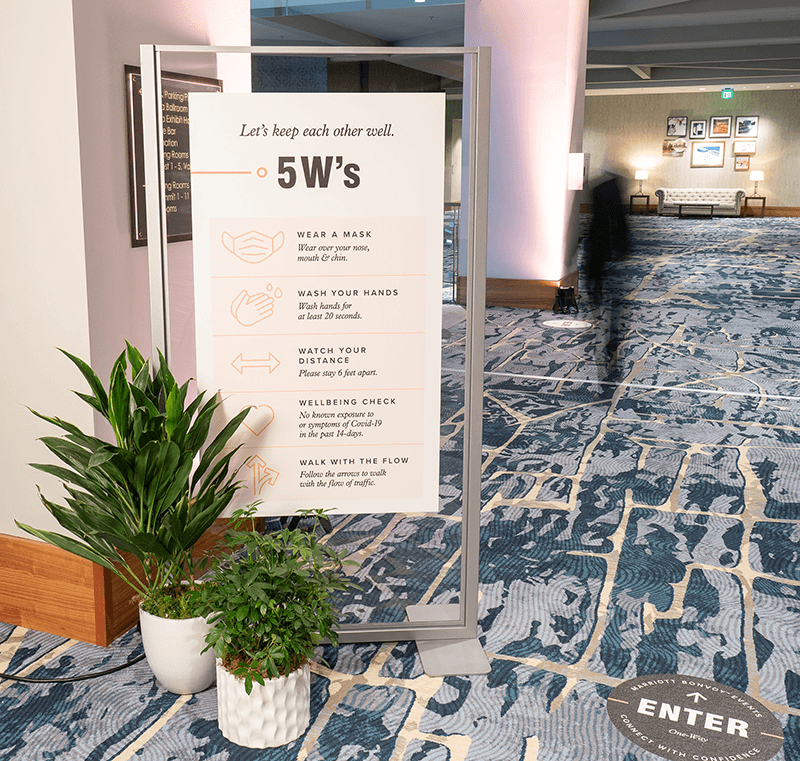
Marriott International and the the Gaylord Rockies Resort hosted 100 attendees for an in-person event as part of the hybrid PCMA Convening Leaders 2021.
As more hybrid events are scheduled in 2021, the business events industry is slowly beginning its recovery. Yet, the ongoing global pandemic has created uncertainty about when exactly face-to-face meetings should return, and when they do return, what will they look like?
“Marriott International is steadfast in our commitment to work with industry organizations like PCMA to support the important work being done throughout the meetings and events industry at this unprecedented time,” said Tammy Routh, senior vice president of global sales for Marriott International. “While 2020 showed us that there is no substitute to meeting face to face, there is an even greater need to reinforce the value of business events going forward, including hybrid, as we work together to revive our industry within a well-being mindset.”
To that end, Marriott International presented the results of its proof-of-case event, which was designed to illustrate and advise how to produce in-person well-being events during COVID times, at Convening Leaders 2021 in the session, “It is Possible! Producing an In-Person, Well-Being Event in Challenging Times.” The session took place at the Gaylord Rockies Resort during an in-person meeting with 100 attendees, the most allowed “per room” as part of state and local guidelines at the time.

Each attendee was provided a “sanctuary seat” supplied with hygiene tips, water, snacks, and other items they might need during the event. The seats were distanced appropriately to meet current safety standards.
The main objectives were to encourage a return to in-person meetings by demonstrating how meetings can take place in the current pandemic environment and provide content and resources helpful to meeting professionals as they embark on the return of those in-person events in 2021.
For the Thought Leadership session, a group of meeting professionals from the PCMA Rocky Mountain Chapter worked with the Marriott International B2B Programs and Events team, the Gaylord Rockies Resort, and supplier partners to design, plan, and execute a hybrid event.
The six pillars of Marriott Bonvoy Events Connect With Confidence guidelines — Commitment to Clean, Contact-Lite Experience, Hybrid Meetings, Physical Distancing, Redesigned Food and Beverage, and Flexible Terms — provided the basic framework of the endeavor, advising meeting planners on how to produce an event in which attendees could “connect with confidence.”
Each planner was given an element of the event to plan and had to vet everything against the pillars and through the lens of well-being. They then reported how they achieved their results, including the challenges, opportunities, and the outcomes.
The case study laid out the entire planning process, from strategy, communications, collaboration, decision-making, and event design, and demonstrated the processes put into place. It also showed how they implemented the 5Ws of well-being behavior and how they incorporated them into the strategic event design. They explored how these components performed before, during, and after the event.
How It Worked On-site
The group set expectations even before the event, communicating the intended event environment in the event invitation and on a website. The goal was to provide a first-hand experience of an in-person meeting built on rigorous well-being protocols.
On-site, attendees went through a temperature screening, voluntary on-site testing, and review of the 5Ws. The main ballroom seating was set up in zones in which individual seats, pre-assigned, were spaced six-plus feet apart. Attendees found their zoned seating area and proceeded to their specific seats. There, they found a mask, necessary sanitizing accessories, their name badge and other meeting materials, individually wrapped in sustainable packaging, complete with a small receptacle for both recyclable and landfill items.
Attendees were also provided wristbands to help visually indicate physical comfort levels for personal interactions:
- Red (keep your distance)
- Yellow (respect my distance)
- Green (elbow bumps welcome but still practicing 5Ws).
From planning and site tours through execution, the team consistently followed well-being ground rules. They coupled this with communications updates, including via a mobile app that pushed out need-to-know information, such as directing attendees to their seating zones.


